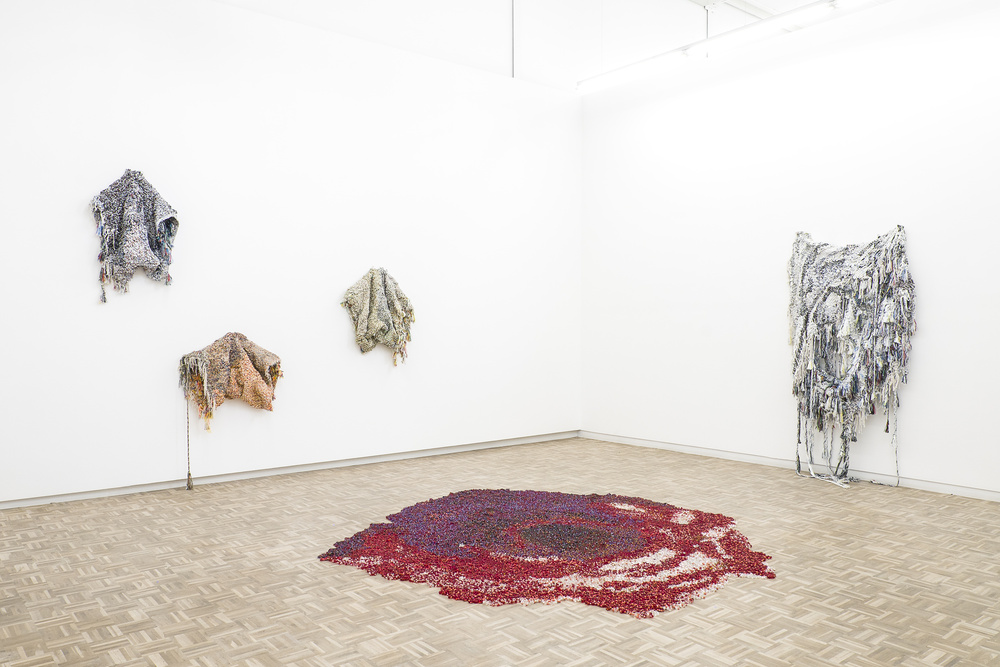Casey Kaplan


A SUBTLE BENEDICTION: IGSHAAN ADAMS’ “AL LATÎF”
A review by Kopano Maroga
23 February 2018
Gallery spaces are strange vestibules. Sites that mark both a violent history of displacement and beauteous escape. Monuments to the multifarious contradictions that comprise humanity. blank projects, with its position in Woodstock in Cape Town – an historically working class suburb and now a working example of the disastrous effects of gentrification on the lives of poor and working class people of colour – serves as an incisive example of the complex and contradictory socio-political history of Cape Town. Moreso with the exhibition of Igshaan Adams’s latest body of work, “Al Latîf,” on display. Adams being an artist who comprises multiple intersections of post-colonial South African identity, and who subtly infuses these identities into his process based work through rigorously and expertly crafted formalist representations. And, much like the socio-political landscape that the exhibition is surrounded by, the devil is in the detail: stille water, diepe grond.[1]
Al Latîf is one of the 99 Beautiful Names of God in Islamic tradition. It can be translated as “the Subtle One”: a single benedictory invocation paying testament to the multiplicities of the divine within a cosmos of invocations. Examples of these invocations include: al-Halim, the Forbearing; al-Khabir, the All-Aware; al-Azim, the Magnificent. This semantic tradition of utilising multiple threads to refer to a single tapestry acts as a beautiful metaphor when counterposed with Adams’ work. In “Al Latîf,” Adams invites us to look closer, to appreciate the ethereal forms rendered through arduous amounts of labour. As though each separate piece of the exhibition were a bead on a rosary; perhaps an allegory on process as prayer.
Adams, when speaking of his work, often refers to his process as quite integral to his practice, the products of that process being important in a different way: markers of what had taken place to get there.
I have always taken a personal approach to making the work… As soon as I’m done, I detach myself completely. For me, it’s the process of making the work that becomes meaningful. I get to understand these conflicting aspects of myself.
For an artist with so many hypervisible socio-political identities (coloured/black, queer, Muslim) the amount of restraint in Adam’s work is an exciting departure from a landscape wherein which artists who exist at the intersection of non-normative identities are pressurised into performing these identities for the gaze of a normative audience. Performing and exhuming their trauma ad infinitum at the behest of the normative, white imaginary. This practice extends into the critical domain where art writers superimpose their zoological fascination with the Other onto the work of artists from marginalised and othered identities. A practice which is thoroughly critiqued by Anna Stielau in the article Stranger Things: Igshaan Adams “Oorskot”:
the artist’s ongoing project is to reconcile his sexuality and his faith, we are told, and his art emerges at the intersection of those two categories of experience. The words “GAY” and “MUSLIM” (I imagine them in all caps) rub up against one another, causing sparks.
Here’s my problem with the uninterrogated application of these labels. They stick to some bodies more than others. However inadvertently, the terms distance ideological monoliths like whiteness, maleness, Christianity and heterosexuality from the mechanics of embodiment.
Adam’s subtle hand subverts this tradition by imbuing the form of his work with its content. The conversation shifts from a zoological fascination with the Other to a layered and subtle introspection into the precarities of form.
Through a process of weaving, beading, crocheting and various other manipulations of fabric, bead and wire Adams renders a body of work with an ethereal levity juxtaposed by the contradictory density of its content and the scale of the works he creates. Adams reimagines the subtleties of the universe in pieces such as “Rahma-(Grace),” which is a beaded floor installation that reads as a rose silhouetted constellation. An homage to the wonders of the natural world and the celestial bodies that hang in perpetual motion just above our heads. What is a daily, easily forgettable phenomena is made a marvel by the painstaking and precise arrangement of one bead after another to create a spectacle of celestial flora. An elegy to the subtle congruences that lie within the universe; the mirror images that allude to a kind of divine design that expands beyond our third rock from the sun. In “Conduit I” Adams renders the approximation of a wormhole through braided and entwined fabrics. A testament to Adams’s craftsmanship as he manages to make the work look weightless as though indeed we are observing an inter-dimensional portal into another plane.
What excites me about this kind of work are the allegories that become imbued into the work and the practice itself. As mentioned before, it isn’t easy to be an artist of colour with other intersecting, marginalised identities as the tendency is for these kinds of artists work to be reduced to their socio-political content with little appreciation for their craft. Adams is undoubtedly an expert craftsman, executing a formalistic inquiry into the gifts and grace of the divine alongside allusions to the fissures and ruptures that are part and parcel of this design. Somehow, all working together to weave together a tapestry of the mundanity and ceaseless wonder of being a single thread in an ever subtly shifting universe.
[1] An Afrikaans saying that translates to the English equivalent, “still waters run deep”.